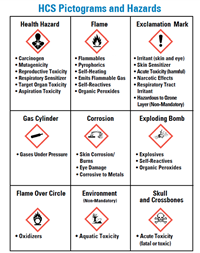Public sector workers have potential exposure to numerous chemicals in the workplace such as petroleum-based products, solvents, acids, caustics, cleaning agents, agricultural chemicals, adhesives, and coatings. New Jersey’s Hazard Communication Standard (HCS) has been adopted to ensure that employees working with hazardous chemicals receive effective information and training prior to working with such chemicals.
New Jersey PEOSH has adopted the OSHA Hazard Communication Standard of 2012, which incorporates the United Nations' Globally Harmonized System of Classification and Labeling of Chemicals (GHS). GHS provides for a uniform approach for the classification and presentation of hazard information.
Effective June 5, 2017, PEOSH added additional HCS requirements for training and documentation, providing stronger protection for New Jersey’s public employees. The PEOSH Hazard Communication Standard requires that employers:
- Maintain a list of hazardous chemicals in each workplace.
- Ensure all hazardous chemicals are labeled. All labeling of hazardous chemicals must include pictograms, a signal word, hazard and precautionary statements, the product identifier, and supplier information.
- Have Safety Data Sheets available for each hazardous chemical and ensure they are readily accessible to employees when they are in their work area(s). Safety Data Sheets (previously referred to as Material Safety Data Sheets) now require a consistent 16‑section format and universal pictograms.
- Train all workers who are potentially exposed to hazardous chemicals. Hazard Communication Standard training must be provided by a technically qualified person, on paid time, and in a manner consistent with the educational level, literacy, and language of the employee being trained (N.J.A.C. 12:100-7.3 - Employee information and training).
- Provide refresher training every-other-year and upon introducing a new hazard to the workplace.
- Maintain a written Hazard Communication Program that includes the employer’s plan for doing the above tasks.




